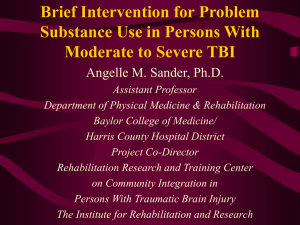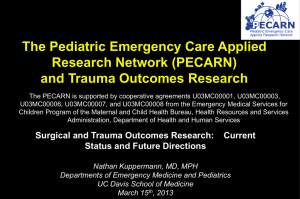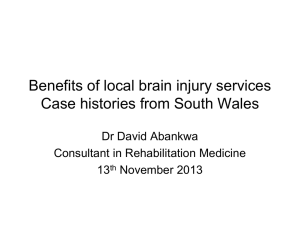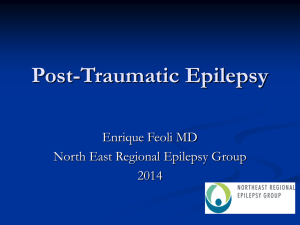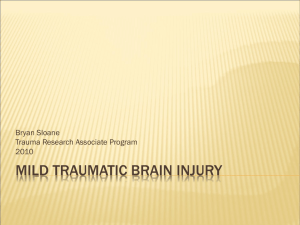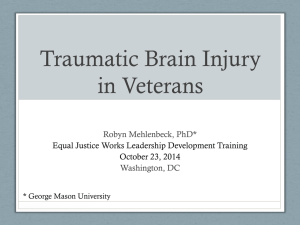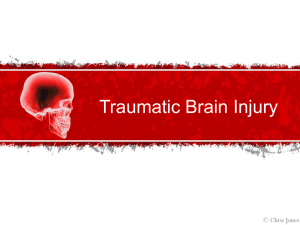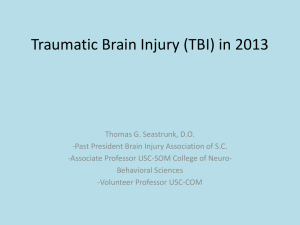Isolated severe injury mechanism
advertisement
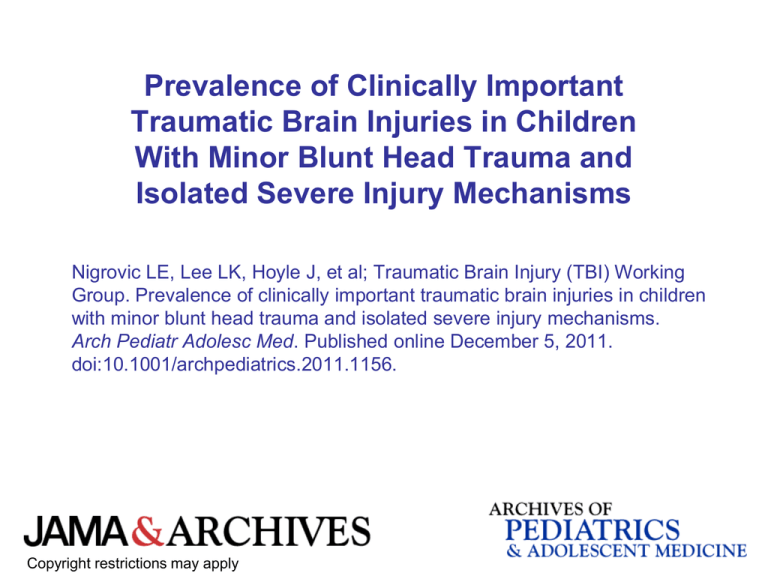
Prevalence of Clinically Important Traumatic Brain Injuries in Children With Minor Blunt Head Trauma and Isolated Severe Injury Mechanisms Nigrovic LE, Lee LK, Hoyle J, et al; Traumatic Brain Injury (TBI) Working Group. Prevalence of clinically important traumatic brain injuries in children with minor blunt head trauma and isolated severe injury mechanisms. Arch Pediatr Adolesc Med. Published online December 5, 2011. doi:10.1001/archpediatrics.2011.1156. Copyright restrictions may apply Introduction • Background – Minor blunt head trauma is a common reason for emergency department evaluation of children. – Risk of traumatic brain injury (TBI) is low. – Severe injury mechanism is a predictor of clinically important TBI in the Pediatric Emergency Care Applied Research Network (PECARN) prediction rules.1 • Study Objective – To determine the prevalence of clinically important TBIs in children with severe injury mechanisms and no other PECARN predictors. 1. Kuppermann N, Holmes JF, Dayan PS, et al; Pediatric Emergency Care Applied Research Network (PECARN). Identification of children at very low risk of clinically-important brain injuries after head trauma: a prospective cohort study. Lancet. 2009;374(9696):1160-1170. Copyright restrictions may apply Methods • Study Design – Secondary analysis of a prospective cohort study. – Conducted by the PECARN. • Participants – Children aged <18 years with minor blunt head trauma. • Glasgow Coma Score ≥14. – Excluded patients with trivial trauma, penetrating trauma, comorbidities, or previous cranial computed tomography (CT). • Injury Mechanisms – Severe injury mechanism: motor vehicle collision with patient ejection, death of another passenger, or rollover; pedestrian or bicyclist without helmet struck by a motorized vehicle; falls (>3 ft if aged <2 years and >5 ft if aged ≥2 years); or head struck with high-impact object. – Isolated severe injury mechanism: severe injury mechanism with no other PECARN TBI predictors. Copyright restrictions may apply Methods • Outcome Measure – Clinically important TBI: TBI resulting in death, neurosurgical intervention, intubation for >24 hours, or positive CT findings in association with hospital admission for ≥2 nights for management of head trauma. • Data Analysis – Subgroups by age: <2 years vs ≥2 years of age. – Rate of clinically important TBI with 95% CI. • Limitations – Not all eligible children were enrolled. – Cranial CT was not performed on all patients. – Caregivers of children with nonaccidental trauma may not report injury mechanism accurately. Copyright restrictions may apply Results • Enrollment – 42 412 patients (78.3% of the 54 161 eligible patients) were enrolled in overall cohort study; 42 099 (99%) had an injury mechanism recorded and were included in this substudy. • 5869 (14%) had severe injury mechanisms. • 3302 (8%) had isolated severe injury mechanisms. • Rates of clinically important TBI in children with isolated severe injury mechanisms: – Children aged <2 years: 0.3% (95% CI, 0.1%-0.8%). – Children aged ≥2 years: 0.6% (95% CI, 0.3%-1.1%). Copyright restrictions may apply Results Injury mechanism varied by patient age. Overall, children with nonisolated severe injury mechanisms had higher rates of clinically important TBI. Copyright restrictions may apply Results Children with isolated severe injury mechanisms had a lower rate of clinically important TBI than those with severe injury mechanisms and other PECARN TBI predictors. Copyright restrictions may apply Results The risk of clinically important TBI increased for children with severe injury mechanisms and 1 additional PECARN TBI predictor. Copyright restrictions may apply Comment • Risk of clinically important TBI is very low in children with isolated severe injury mechanisms. – Clinical observation for development of signs or symptoms of TBI may be an effective clinical strategy. • After careful evaluation and observation without development of signs or symptoms of TBI, many children with isolated severe injury mechanisms may not require emergent neuroimaging. Copyright restrictions may apply Contact Information • If you have questions, please contact the corresponding author: – Lise E. Nigrovic, MD, MPH, Division of Emergency Medicine, Children’s Hospital Boston, 300 Longwood Ave, Boston, MA 02115 (lise.nigrovic@childrens.harvard.edu). Funding/Support • This work was supported by a grant from the Health Resources and Services Administration/Maternal and Child Health Bureau (HRSA/MCHB), Division of Research, Training and Education (DRTE), and the Emergency Medical Services of Children (EMSC) Program (R40MC02461); the PECARN is supported by cooperative agreements U03MC00001, U03MC00003, U03MC00006, U03MC00007, and U03MC00008 from the EMSC program of the HRSA/MCHB. Copyright restrictions may apply

